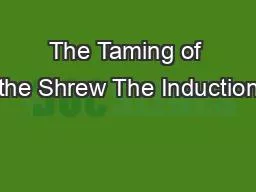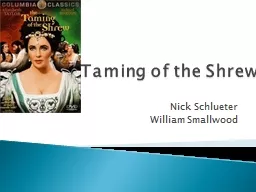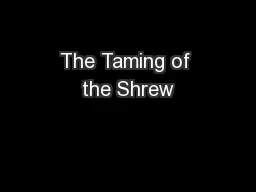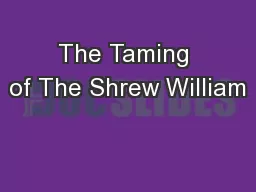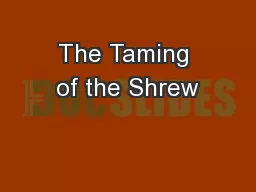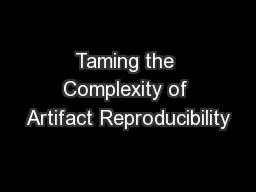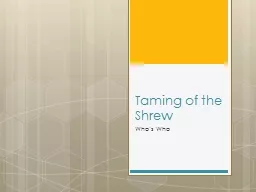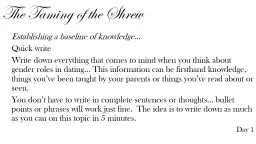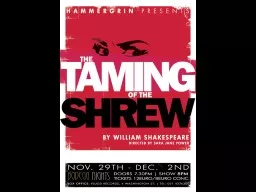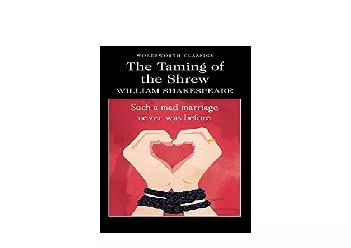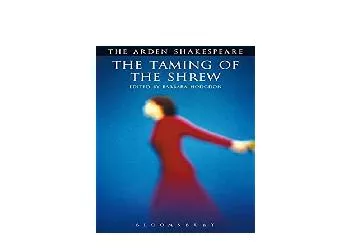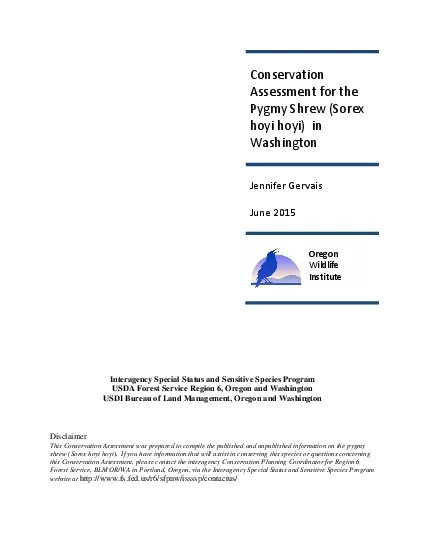PPT-The Taming of the Shrew The Induction
Author : billiontins | Published Date : 2020-07-02
The induction Induction III Summary Induction I Outside an alehouse somewhere in the English countryside a drunk beggar named Christopher Sly argues with the Hostess
Presentation Embed Code
Download Presentation
Download Presentation The PPT/PDF document "The Taming of the Shrew The Induction" is the property of its rightful owner. Permission is granted to download and print the materials on this website for personal, non-commercial use only, and to display it on your personal computer provided you do not modify the materials and that you retain all copyright notices contained in the materials. By downloading content from our website, you accept the terms of this agreement.
The Taming of the Shrew The Induction: Transcript
The induction Induction III Summary Induction I Outside an alehouse somewhere in the English countryside a drunk beggar named Christopher Sly argues with the Hostess over some glassware he has broken in his inebriated clumsiness While the Hostess leaves to find the local authorities Sly passes out and soon a lord returning from the hunt discovers him . How much do we know about Shakespeare's life?. A) Almost nothing. We can only make guesses.. B) Some significant details (birth?, marriage, death, major events, some business details). We can make educated guesses about some personal details.. Nick Schlueter. William Smallwood. The Taming of the Shrew is a comedy by William . Shakespeare.. The play begins with a framing . device, known as . the . Induction, in . which a mischievous nobleman tricks a drunken tinker named Christopher Sly into believing he is actually a nobleman himself. The nobleman then has the play . :. The Taming? Of the Shrew?. Do you think Kate wants to get married?. Yes. . No. . Dude, I, like, just don’t know.. Why would Kate act like a shrew, which is both socially denigrating and off-putting to suitors, if she really wants to get married?. leaves. Plant sap. Flower nectar. slug. Caterpillar. Aphid. butterfly. rabbit. fox. bluetit. sparrowhawk. shrew. Producers. Primary Consumers. Secondary. Consumers. Tertiary Consumers. QuaternaryConsumers. Shakespeare. An Introduction. The Taming of the Shrew. The idea of beating one’s wife to make her obey was acceptable behaviour in Medieval times.. The Taming of the Shrew presents a different, more radical alternative.. Review. Take Notes . . Characters. Christopher Sly: drunkard thrown out of an ale house. Bartholomew: the drunkard’s “wife” . Lucentio. : in “love” with Bianca; later elopes with Bianca. Matthias Flittner. 1. , Robert Bauer. 1. ,. Amr . Rizk. 2. , . Stefan . Geißler. 3. , . Thomas . Zinner. 3. , . Martina . Zitterbart. 1. 1. Karlsruhe Institute . of. Technology, . 2. Technische . Universität Darmstadt, . “Willy Shakes”- aka William Shakespeare. Born in 1564.. Married at the age of 18 to Anne Hathaway- they had three children.. Moved to London in 1592.. Died at 53.. Will’s Language. He actually introduced an estimated 3,000 new words into the English language:. Quick write. Write down everything that comes to mind when you think about gender roles in dating… This information can be firsthand knowledge, things you’ve been taught by your parents or things you’ve read about or seen. . The available evidence supports a very early date for the play’s creation, and 1593-1594 is often suggested.. . The structure of the play is unique because it the only work by Shakespeare that is a . \"$$[Epub]$$ The Taming of the Shrew Wordsworth Classics ^#DOWNLOAD@PDF^#
Trusted since 2010
\" \"$$[Epub]$$ The Taming of the Shrew Arden Shakespeare Arden ShakespeareThird Series The Arden Shakespeare $$[Epub]$$
Trusted since 2010
\" EXECUTIVE SUMMARY SpeciesPygmy shrew Sorex hoyi hoyiTaxonomic GroupMammalManagement StatusThis species is given a conservation status of 147least concern148 by thIUCN and it has no Federal status in t Allow junior doctors to move more freely throughout the NHS through flexible virtual induction programmes. Ensure training continued throughout the pandemic, improve . work-life balance and feeling of belonging and connection within their teams.
Download Document
Here is the link to download the presentation.
"The Taming of the Shrew The Induction"The content belongs to its owner. You may download and print it for personal use, without modification, and keep all copyright notices. By downloading, you agree to these terms.
Related Documents

